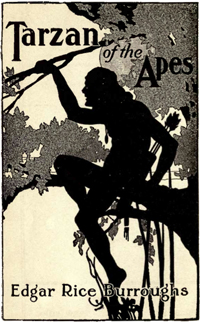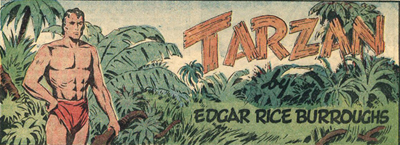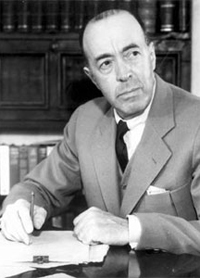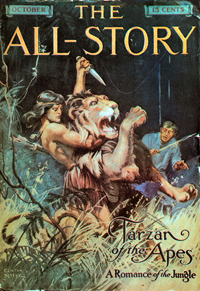
By Murray Ewing. Originally published in Cybernet2000 #16, Aug 1998

Tarzan may well be the Twentieth Century’s bestselling and most widely-known fictional hero. If this seems a bit of an exaggeration, it’s only because the Lord of the Jungle has been taking a much-deserved rest recently, and has dropped out of the public eye. But that is set to change.
Every generation has its own image of Tarzan, whether it is the lion-wrestling savage from the covers of All-Story Magazine where he first appeared, the athletic Johnny Weismuller, most famous of the film Tarzans, the rotoscope-animated character of the 1976 cartoon series, the fierce-looking Christopher Lambert of 1984‘s Greystoke: The Legend of Tarzan — or the countless other incarnations, each with their own version of the famous cry, and with or without their collective mate Jane, she-who-must-be-eternally-rescued-from-peril.
And a new batch is starting to appear. 1996 saw Tarzan’s revival in the sword-and-sorcery-tinged US TV series, Tarzan: The Epic Adventures, staring Joe Lara. 1998 brings about the first proper Tarzan film for over a decade, Tarzan and the Lost City.
And, as if all this wasn’t enough, 1999 will see the release of a Disney version of the ape man’s exploits, featuring the voice of Glen Close as Tarzan’s ape mother Kala and — of all things — the music of Phil Collins.

But there is a definitive version.
On 6th March 1912, fledgling pulp writer Edgar Rice Burroughs wrote to Thomas Metcalf, the editor of All-Story Magazine: “I have been working at odd moments on another of the ‘improbable’ variety of tale...”
He had, at that point, only had one story published (Under the Moons of Mars, later to appear in book form as A Princess of Mars, the first adventure of John Carter), and one rejected (The Outlaw of Torn, an historical drama notable only because it featured the appearance of Lord Greystoke, one of Tarzan’s ancestors). The first was most definitely of the “improbable” variety, while the rejected tale was not. Burroughs now knew what he could and couldn’t write.
His new “improbable” story was based on his childhood fascination with the legend of Romulus and Remus, who, thrown into the river Tiber as children, has been suckled by a she-wolf, and later grew up to found the city of Rome.

Burroughs wrote: “This interest, I presume, led to conjecture as to just what sort of an individual would develop if the child of a highly civilised, intelligent and cultured couple were to be raised by a wild beast...”
For his “intelligent and cultured couple” Burroughs chose Lord and Lady Greystoke, set down on the jungle coast of Africa when the crew of their ship mutinies. For his wild beast, he chose Kala the she-ape, who cares for the new-born, orphaned John Clayton when her own child is killed. She names him “Tar-Zan”, which means “White Skin” in the ape-language Burroughs devised.
The finished tale, Tarzan of the Apes, starts off atypically for Burroughs, who is normally a straight-into-the-adventure man, by following Tarzan’s development as he struggles to compensate for the weaknesses of his human body in contrast to those of his ape brothers. He learns to use the one thing he has that they don’t — his intelligence — and climbs to the head of the tribe.
When he is fully grown, another mutinying crew of another passing ship puts down its passengers, including not only Tarzan’s future wife Jane Porter, but his closest surviving relative, Lord Cecil Clayton Greystoke. Burroughs was never one to let a coincidence get in the way of a good tale.
Adventure ensues. Tarzan, who has learnt to read English from the books his father brought with them but cannot speak it, rushes around saving this group from the many dangers they encounter, falls in love with Jane, and then follows her to civilisation — where he duly rescues her from peril once more. However, the book ends not with Tarzan claiming his mate and vine-swinging off into the sunset, but with his return to the jungle alone while Jane announces her intention to marry Cecil Clayton.

With such an ending, it seems obvious that Burroughs was already planning a sequel. All his plots are driven by romance; the heroes are constantly saving their loved ones only to have them snatched from their grasp, and so need saving once more. But, when Metcalf asked for a sequel, Burroughs demurred, pretending he wasn’t that interested. He was, perhaps, hoping for an offer of better rates of pay.
So Metcalf suggested a plot in which Tarzan, finding himself unable to be at home in either the jungle or civilisation, goes mad until he finds a half-wild woman raised in the jungle like himself.
Burroughs eventually wrote the sequel, The Return of Tarzan, but thankfully used a better plot. Jane is once again marooned in the jungle, Tarzan saves her from peril a few times, and they are married.
23 sequels followed. In them, Tarzan discovers lost empires, defeats Nazis, travels to the Earth’s core, and joins the Foreign Legion.
In 1918, the first Tarzan feature film appeared. It was a big hit and turned its production company, The National Film Corporation of America, into a major player. There is a rumour that Elmo Lincoln, who played Tarzan in the film, actually killed a very old lion in one action sequence.
To date, there have been 45 more. There have also been 5 adventure serials (one of which starred Buster Crabbe, who later played Flash Gordon and Buck Rogers), a newspaper strip, a radio series (whose Jane was played by Burroughs’ own daughter, Joan, with her husband James Pierce, a former screen Tarzan, in the lead role), countless comics (from 1974‘s Tarzan and the Devil Ogre to 1992‘s Tarzan the Warrior), four TV series, and “The Tribes of Tarzan”, an attempt by Burroughs to start a movement like the boy scouts, complete with jungle chants and a badge of merit, which had, at its height, 125,000 members.
And then there are the imitations. In fiction, there have been Kaspa the Lion Man, Kioga of the Wilderness, Ka-Zar, Ki-Gor, Bantan — God-Like Islander!, Tharn Warrior of the Dawn, Tarn Son of Tiger and Jongor of the Lost Island, to name but a few. In comics, there have been Tarsan, Kanga, Zago, Jungle Jo, Jo-Jo of the Congo, Ka-Zar (again), Thun-da, Nyoka the Jungle Girl, Rulah the Jungle Goddess... Film has given us Bomba the Jungle Boy (title role played by Johnny Sheffield, who played “Boy” in Tarzan Finds a Son! and several sequels), Jungle Jim (with Jim played by a post-Tarzan Weismuller), Sheena, unnumbered foreign-language imitations, and such recent comedy versions as Jungle 2 Jungle and George of the Jungle.
On the success of Tarzan and the John Carter stories, Burroughs formed his own publishing company, Edgar Rice Burroughs Inc., and ran it from his home in the small town that had grown around his ranch in California, which he duly named “Tarzana”.

Tarzan, of noble birth but raised by nature, lives by a simpler, more honourable code of conduct than the civilised men he later meets. He embodies two of Burroughs’ beliefs: that heredity would win out against upbringing, and that civilisation corrupts.
Of course, Burroughs was later to admit that a person brought up in the wild would most likely not live up to the heroic image he had created: “The more I thought about it, the more convinced I became that the resultant adult would be a disagreeable person to have about the house. He would probably have B.O., Pink Toothbrush, Halitosis and Athlete’s Foot, plus a most abominable disposition...”
Actual accounts of feralism — children being brought up by wild animals — paint an even bleaker picture. In 1921, two girls were discovered living with a pack of wolves in India. They exhibited few human characteristics and, unlike Tarzan, showed no recognition of fellow human beings. One of the girls, aged 3, died within a year of being removed from the wild, most probably from the change in diet. The other, who had been aged 8 when she was discovered, lived to a little less than 16. She managed to learn a few human ways, but in the end spoke only a handful of words. There have been about 40 other records of such instances.
But Tarzan was never intended as a thought-experiment. He was Burroughs’ ideal of fearless heroism, let loose in a world of adventure.
He was also an implied criticism of civilisation:
“I wanted my readers to realise that man alone of all the creatures who inhabit the earth or the waters below or the air above takes life wantonly; he is the only creature that derives pleasure from inflicting pain on other creatures, even his own kind. Jealousy, greed, hate, spitefulness are more fully developed in man than in the lower orders.”
To which the only reply is a mighty chest-thump and a yodelling cry of approval.